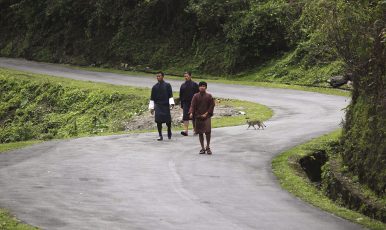
As vote counts results began trickling in toward the end of election day on September 15 in Bhutan, expectant families and neighbors gathered to watch election results over shared meals and beverages. Since the introduction of parliamentary elections in 2008, these political contests have also become an opportunity for social festivity.
Using an SMS-based Poll Information System, the Election Commission of Bhutan at Thimphu was able to complete the majority of the ballot counting within a few hours of the country’s 865 poll stations closing.
It became clear early on that the ruling People’s Democratic Party would be eliminated from the country’s unique parliamentary representation system, in which only two parties exist in the parliament, while multiple parties can exist outside of it.
Enjoying this article? Click here to subscribe for full access. Just $5 a month.Election to the House of Representatives, also called the National Assembly, occurs in two rounds: the Primary Round and the General Round. The first round, called the Primary Round, is contested by multiple parties. This year, four parties contested, two of which have existed from the first parliamentary elections.
The People Democratic Party (PDP) was led by a Harvard-educated former civil servant who was viewed as a popular political leader. Opposing him was the Druk Phuensum Tshogpa (DPT), which formed the first democratic government, and was the opposition party in the last parliament. The two new parties were the Druk Nyamrup Tshogpa (DNT), which was led by a popular medical doctor and social activist, and Bhutan Kuen-nyam Party (BKP), which is headed by the former chairperson of the Anti-Corruption Commission. The parties did not vary substantially in terms of ideology or manifestos, but they represented their respective party leaders’ expertise and personal values.
On Election Day, provisional results broadcast by the national television network showed that the voter turnout was 66.36 percent, a substantial increase from the 55.3 percent in the 2013 elections. According to the data, 291,098 voters cast their ballots out of the total 438,663 registered voters. Of that amount, 144,028 (49.5 percent) were male and 147,070 (50.5 percent) were female.
The past elections revealed an unmistakable decline in voter turnout, which needed improvement. The Election Commission of Bhutan carried out massive civic education activities using the expertise and experience of mature democracies and facilitated by global organizations such as International IDEA. Other corrective measures were procedural in nature. Given Bhutan’s mountainous terrain and often hazardous travel conditions, voting in person can often be prohibitive. Therefore, postal booths were set up across the country to facilitate voting for eligible voters. Out of the 102,531 registered to vote through the “Postal Ballot Facilitation and Mobile Booths,” a total of 79,515 people voted with an overall voter turnout of 77.55 percent in that category.
Observers have pointed out that the results demonstrated the growing maturity of the Bhutanese electorate. Past elections saw certain parties winning the majority of the votes, and that was seen as evidence of the people’s inexperience with electoral politics. For instance, in the very first election in 2008, the winning party won 45 of 47 seats, leaving the opposition in a marginal position. It seemed that voters voted along party lines, instead of taking into consideration individual candidates from their constituencies. The voters failed to distinguish between parties and their candidates. The second election saw similar voting pattern, although with some improvement. This election showed an even distribution of votes across all parties, with the DNT winning 92,722 (31.8 percent) votes as against 90,020 (30.9 percent) for the DPT, 79,883 (27.4 percent) for the PDP, and 28,473 (9.7 percent) for the BKP.
Standing third, the ruling PDP was eliminated from the run-off General Round of elections to be held within a month’s time. Both eliminated parties were quick to accept the results, with the PDP’s president stating that the “people have spoken.”
The results showed two trends that were anticipated in Bhutan’s small voting population, and for which systematic safeguards were put in place. The first was a region-based voting pattern, with the DPT sweeping the eastern and central region constituencies, while the DNT prevailed in most of the western and southern districts. The constitutional requirement of political parties to be nationally representative by having candidates in each of the country’s 47 constituencies was established to safeguard against a divisive and potentially destabilizing regional split.
The other trend was the influence of urban voters on electoral outcomes. Many of these voters cast their votes through postal ballot facilities, and they proved to be the deciding factor. The PDP secured the maximum votes cast in person using the electronic voting machines in the 865 polling stations set up across the country. However, the two qualifying parties’ share of postal ballots left a huge deficit that their rivals could not overcome.
On October 18, the country will again go to the polls for the General Round where the two qualifying parties will contest in each of the 47 constituencies. The party securing the majority of seats will then form the next government. Bhutan has held several elections for the two houses of the parliament, and as long as voters remain engaged and defeated parties graciously accept defeat, a spirit of festivity will prevail.
A previous version of this article incorrectly listed the election date.
Karma Dema is the Bhutan Programme Management Coordinator at the International Institute for Democracy and Electoral Assistance (International IDEA).
